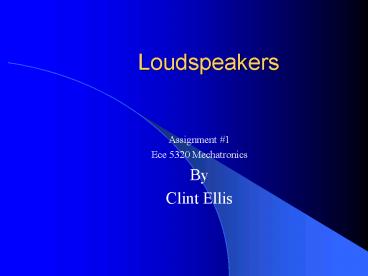Loudspeakers - PowerPoint PPT Presentation
1 / 15
Title:
Loudspeakers
Description:
... Radiators Used in stereophonic systems Magnet types The three main types of magnets used in speaker construction Electomagnetic Speaker Structor The left ... – PowerPoint PPT presentation
Number of Views:710
Avg rating:3.0/5.0
Title: Loudspeakers
1
Loudspeakers
- Assignment 1
- Ece 5320 Mechatronics
- By
- Clint Ellis
2
Outline
- References
- Major Applications
- Basics
3
References
- Rossing, T. (2002) The Science of Sound. San
FranciscoAddison Wesley - The Speaker Building Page, 06 Mar 2004
http//www.speakerbuilding.com/ - Moy, Chu Notes on DIY Electrostatic Headphones
http//headwize2.powerpill.org/projects/showproj.p
hp?filecmoy3_prj.htm
4
Major Applications
- Noise elimination
- Sound reproduction
- Sound amplification
5
Loudspeaker Types
- Electrostatic Speakers
- Similar to a condenser microphone design
- Air-motion Transformers
- Diaphragm ran
- Ribbon Speakers
- Similar to a Ribbon microphone design
- Planar Speakers
- Flat shape but inefficient
- Cylindrical Radiators
- Used in stereophonic systems
6
Magnet types
Figure from The Science of Sound Rossing From
left to right A slug magnet, ring magnet, W
magnet
- The three main types of magnets used in speaker
construction
7
Electomagnetic Speaker Structor
- The left side is an exploded view of the
construction of a speaker - The right is the view of the magnet and voice
coil structors
Figure from The Science of Sound Rossing
8
tweeter horn types
- A straight horn
- A folded horn
Figure from The Science of Sound Rossing
9
Tweeter types
- A cone type tweeter
- A diffraction horn
- Multicellular horn
- Dome tweeter
Figure from The Science of sound Rossing
10
Low-Frequency horn design
- Left is sectional top view of design
- Right is the sectional side view
Figure from The Science of Sound Rossing
11
Equivalent Circuit for a Loudspeaker
- R2 represents the drivers suspension loss
- R3 represents the internal energy absorption
- C1 represents the compliance of the driver
suspension - C2 represents the compliance of the air in the
enclosure - L1 represents the mass of the speaker cone, voice
coil and air load
12
Electrostatic Speakers
Advantages 1. Smooth response at high
frequency2. Can be small (as in headphone
assembly)3. Cheaply manufactured Disadvantages
1. Inefficient at low frequencies2. High input
impedance
13
Planar Speakers
Advantages 1. Flat space saving design2. Can be
constructed as both magnetic and
electrostatic Disadvantages 1. Inefficient at
all frequencies2. Hard to find due to
unpopularity
14
Cylindrical Radiators
Advantages 1. Radiate equally in all directions
2. Can be placed anywhere in a room
Disadvantages 1. Interference effects distort
when used in stereophonic systems
15
Ribbon Speakers
Advantages 1. Clear mid and high frequency 2.
Easy construction Disadvantages 1.
Bidirectionallity causes sound cancellation2.
Weak low frequency because of bidirectionallity































